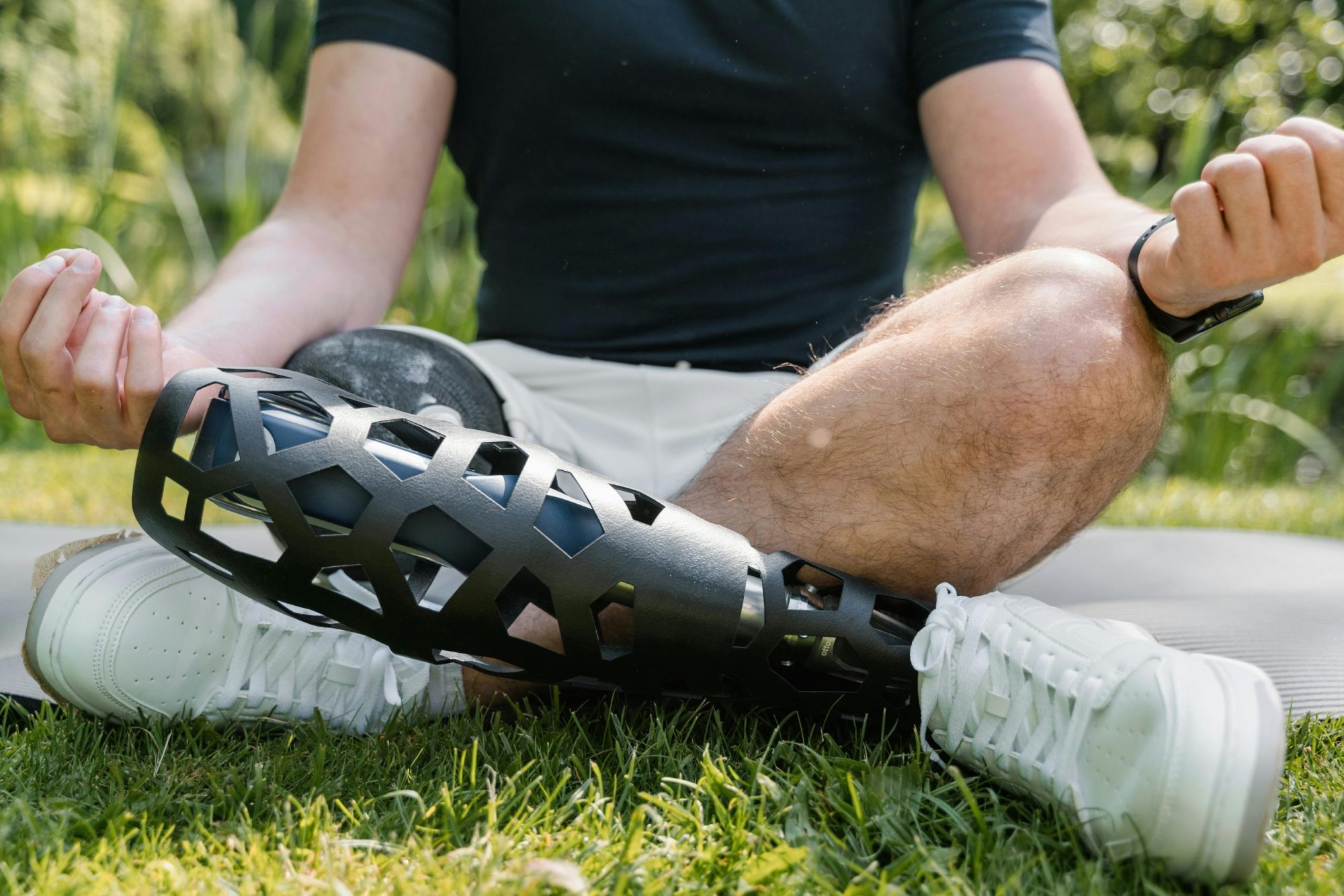Books & Culture
The Promise of Prosthetics Is a Curse
The narrative of the power of technology over disability is ableist and leaves little room for reality

“Prosthetics are so advanced now,” a nondisabled stranger tells me in passing.
“Mine is held on with Velcro,” I reply pleasantly, to give them a splash of real talk, but also they aren’t listening and don’t care. They already have their beliefs set.
The promise of prosthetics is one of restoration of ability, and this narrative leaves little room for reality.
The promise of prosthetics is a rote call-and-response for those looking to inject a little technological optimism into their daily lives, to believe in the power of technology and restoration, and the idea that problems are solved tidy-like. They also then don’t have to worry about disability, or disabled people, or about building that ramp that they are already 32 years late installing.
The promise of prosthetics is an ending of disability, but that’s a promise from people who don’t know disabled people or disabled communities. Disability is longstanding and not going away—the future will give us new ways to be or become disabled. New viruses, new patterns of animal migration and disease thanks to climate change, new weather patterns, hopefully new ideas of work and of good bodies, too.
My body is good.
I love Velcro. I like the sound it makes. I like how well it works with secure fit and adjustability. With my last leg, I used to adjust my Velcros a lot more. I used to have three Velcros, now I have two. Carefully cut, melted, and then sewn with the giant sewing machine in my prosthetist’s lab by his son, who is also his technician. My Velcros are mine only, perfect for my leg.
Imperfect, too.
I used to have white Velcros and a white upper on my prosthesis, but they got skanky and discolored from the darker-wash jeans I prefer, and every little fiber they pick up shows—not that I’m hiking my pants up every day to show off my Velcros, so it didn’t matter that much. I have an old-style prosthesis, almost like a Hanger leg[1] for those familiar with disability design. My amputation is very fancy. Some people like me still use lacers instead of Velcro, and others are using the snappy adjusties you have on skis now, too. High tech.
The promise of prosthetics is one of restoration of ability, and this narrative leaves little room for reality.
I know that there are at least some people who are curious about the intimate relationship I have with my prosthesis as a body part, or, worse, for me to tell you a tale about getting jiggy[2] with my prosthetic leg on, or off. What do I do with this equipment if I want to have sex? What’s the plan for the leg?
But that’s boring. And you’ve read enough idealized tales where bodies sing electric, where man is one with machine, where flesh is made whole again, and where people can then get freaky with the manic pixie cyborg electric-sheep-dream girl.[3]
The disability intimacy I want to address is about when prosthetics are a shield preventing intimacy, when the narratives we have about prostheses put real-life prosthetized people in a pickle. Prosthetics are a shield to other people’s ideas of intimacy that I do not share with them—those who gawk and give unwanted attention, who smirkingly or even sincerely ask things like “leg on or leg off?” My legs are not an invitation to your education, or your desire.
There is no good way to be an amputee because of all the stories and expectations and images that are out there about us, and the questions and information people think they are entitled to through that media, too. The promise of prosthetics is a curse.
Prosthetics are a defense.
Some amputees talk about how they put their leg on first thing and take it off last thing and don’t want to be seen without their leg on. They will literally work through terrible blisters, rashes, and pain to avoid going legless, or be seen outside their homes with any assistive devices other than prostheses.
Disability is longstanding and not going away—the future will give us new ways to be or become disabled.
The promise of prosthetics has meant for them that they need to appear as close to nondisabled as possible. To make themselves invulnerable to other disability narratives that may haunt their existence—of helplessness or need, of shame and pity, and even of just desserts: that they are not trying hard enough to “overcome.”
Instead, the promise of prosthetics—that they re-enable us and make us whole again—requires our constant work to be “good crips,” those who confirm the power of technology over disability.
I’m not against prosthetics; I’m wearing one, aren’t I? We amputees are (or some of us are) quite lucky for the technologies we do have, and the choices about those technologies. I love my leg and my perfect Velcros. Access is key: we should be able to get different types of technologies to try out, and then also afford.
But I also want to be able to take off my leg without fear that people will reconsider their judgments about my capability and competence, my status as re-enabled and whole.
You see, if we crips don’t buy into prosthetics as redemption, they won’t either, and we’ll go back to being seen as incompetent and incomplete. Broken.
My legs are not an invitation to your education, or your desire.
There is actually research about perceptions of people with bionics (prosthetic limbs, retinal implants, exoskeletons). In a paper called “Disabled or Cyborg?” (a false dilemma), researchers share their conclusion from an online study that asked people their impressions of various groups. They gathered that:
“People with physical disabilities who wear bionic prostheses . . . are perceived as more competent than people with physical disabilities in general [but both groups still less competent than nondisabled people] . . . So-called cyborgs are perceived as much colder than able-bodied individuals [and others with physical disabilities without bionics]. . . .”[4]
The fact is that puzzling out how to do things differently can offer a space of personal creativity and new surprise and pleasure in the mundane tasks. But I only hear those stories in disability groups (and not just amputee groups), and then only rarely and sometimes abashedly. Joy is not what we’re supposed to feel or what we’re supposed to share to get “peer support.” These crip intimacies include not a triumph over something, but the sharing of everyday tricks and ways we have, in sharing the creativity of our embodiments with and for one another.
Prosthetists and physical therapists get praised for their humanitarian work. News stories pump up engineers working on better prosthetic feet or hands. But I really like Fred’s Legs: an amputee and his spouse sell stretchy prosthetic socket covers out of stretchy fabrics, sewn on a home machine with some small customization possible. This is very cheap and easy tech, and they ship all over. I don’t need a prescription to order from Fred. I don’t need to leave my home. The things we do, get, and learn, and even sometimes buy from each other are never on the nightly news. They can’t see us in our making and our sharing, with joy and some frustration and community, too; they want too much for us to be tragedy so the abled can be the heroes, can save us. The promise of prosthetics is that a humanitarian engineering team takes over.
I want to be able to take off my leg without fear that people will reconsider their judgments about my capability and competence.
Prosthetic devices make it so that we may pass for a time as less disabled (or at least stave off being recognized as disabled under some circumstances)—this includes cases of breast prostheses and cosmetic prosthetic covers for arms and legs. With my leg, I look ambulatory, though I might look disabled with a limp or cane. I look less disabled to other people; I am no different, but different perceptions get placed upon me. People can forget for a time that I am disabled.
Showing up wearing my prosthesis means I get routed to a long staircase. (No thank you.)
Passing is its own burden: to avoid being fully seen, but also to avoid being discounted. Because disabled people are discounted. “Disabled or Cyborg?” Best to stick to the side where you are judged as cold but competent.
Of course, it’s a luxury many non-prosthetized disabled people don’t enjoy: to be able to convince others of not-quite-the-truth, playing on their expectations.
Better to pass sometimes, and deliberate carefully about disclosure:
- When and to whom you reveal yourself (and whether they will treat you differently after that disclosure),
- Where your need for accommodation or access is so great that you have to disclose (and whether what you then encounter is retaliation for being disabled),
- How to best explain your body and what this explanation will produce in those around you (e.g., pity, understanding, questions about your ability to live/laugh/love and work).
I do this, too—ask myself about what I reveal as a hard-of-hearing, chemo-brained amputee with Crohn’s and tinnitus—where disclosure is important and not. Rarely am I handing out the list, and recipients wouldn’t know what to do with the list anyway.
The promise of prosthetics to this cyborg is that I can push people away who would do me damage.
There is a list of people I try to appear as abled as possible to. People who would weaponize any perceived incompetence against me. People who would swoop down in helper mode to make me doubt myself. People who would point out perceived faults to my children or my colleagues. People who would cry about me, even though I have no tears for me. People who have said enough nonsense about other disabled people that they cannot be trusted.
A couple shares a story about a friend who became “a vegetable,” but they just mean quadriplegic. He got a spinal cord injury from an accident. They visited him at his home once about six months after his accident, judged him to be too sad, and never visited their once-friend again.
So awkward to watch people tell a story with no self-reflection or shame, recognizing that they would just as soon turn away from you—judge you and your life “too sad” from a single visit.
And perhaps tell my partner he should leave me, and take our kids. His leaving would be typical of the experience of a woman who acquires a disability: our partners are statistically much more likely to leave. And parents with disabilities are at much higher risk of having their children taken away.
They have told a short anecdote from decades ago, and they have opened up my mind to a series of horrors that would undo the life I know and remove the support I have.
They tell this story in passing, and so I pass as hard as I can.
The promise of prosthetics is that I can betray my disabled brethren and fuel the ableist narratives that feature bodies like mine.
I keep my leg on all day when they visit, on my feet and busy working, and every visit after. There are physical consequences to appearing this way, trying to put on the ruse that I am not “really disabled,” or at least not in the way they would find sad.
I get called an inspiration, and I know the vast separation between their experience of me and my actual experience. I want to scream, but can’t have them suspect mental infirmity in addition to my physical invalidity.
I want no intimacy with them. I will choke down an Advil, smooth on extra Adaptskin 50, and be absolutely exhausted trying to keep up the ruse that I don’t need to sit down, don’t need to slow down.
The promise of prosthetics goes:
Gaslight (prosthetics are so advanced now),
Gatekeep (you certainly aren’t like those other disabled people),
Girlboss (you can do it all, forsake your bodymind).
The promise of prosthetics is that I can betray my disabled brethren and fuel the ableist narratives that feature bodies like mine. The promise of prosthetics means that I can pretend for a while and hide my vulnerability away—people will believe me “re-enabled” if I appear just so, play into their expectations about prosthetics. “Wow,” they say. “Prosthetics really are so advanced; you get around great on that thing.”
Footnotes:
- Imagine a classic historical post–Civil War old-timey leg with a below-knee socket and joints on either side of the knee and an upper leather portion around the thigh that laces up to hold the leg on securely. ↩︎
- Do people still use “getting jiggy” as a euphemism for sex? ↩︎
- “Not a girl,” says Janet from The Good Place. ↩︎
- See Bertolt Meyer and Frank Asbrock, “Disabled or Cyborg? How Bionics Affect Stereotypes Toward People with Physical Disabilities,” Frontiers in Psychology vol. 9, November 20, 2018 (Chemnitz University of Technology). There is a lot to unpack about this study and the categories used, but that goes beyond the scope of this essay! ↩︎
From Disability Intimacy edited by Alice Wong. Compilation copyright © 2024 by Alice Wong. Copyright © 2024 by Dr. Ashley Shew. Published by arrangement with Vintage, an imprint of The Knopf Doubleday Group, a division of Penguin Random House LLC.









